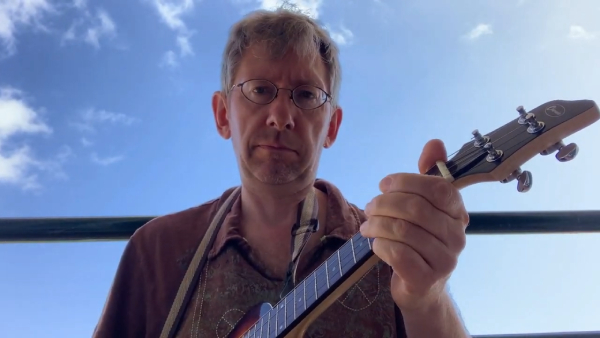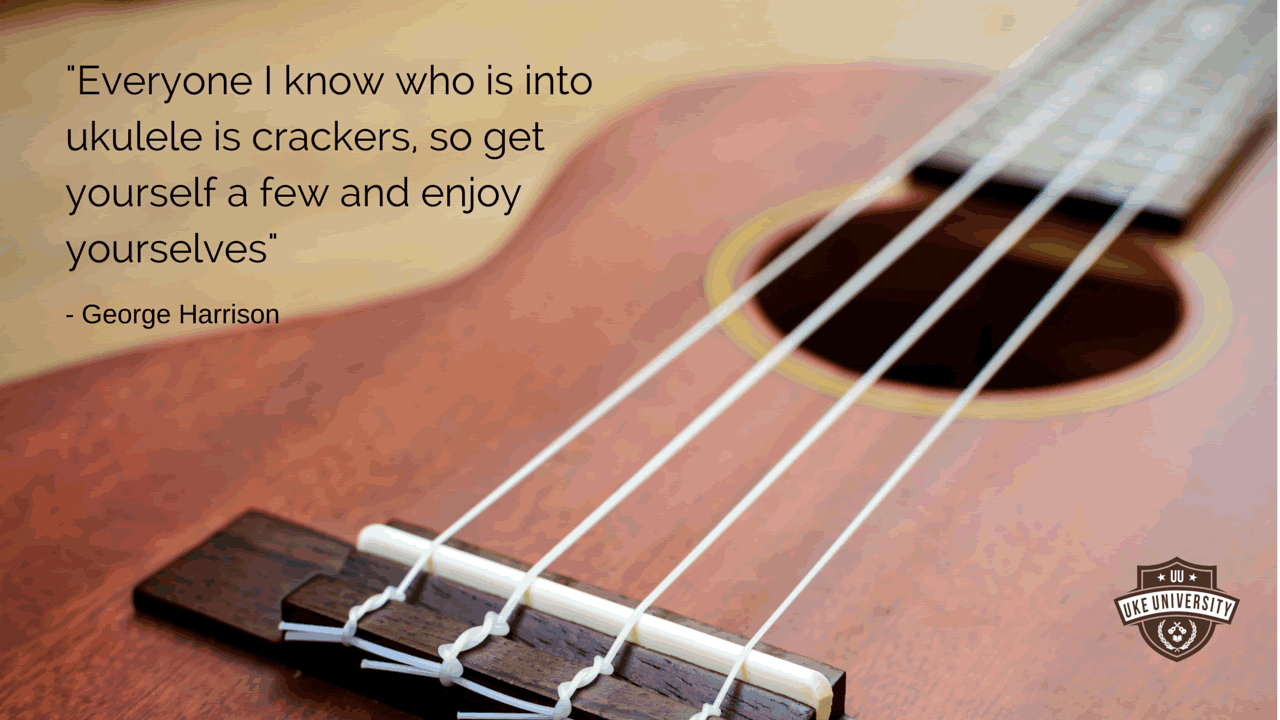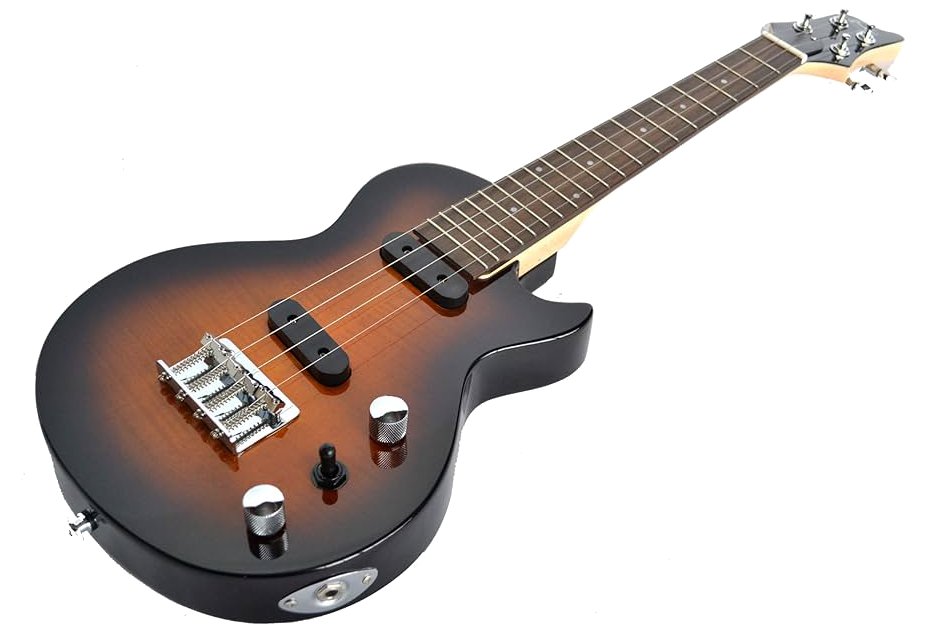
|
Ken's Electric Ukulele Tabs
This is a website about playing the electric ukulele, which yes, is
a thing. If you are a guitar purist, or you have very firm opinions
on gear, you likely won't like this site and might already feel your
blood pressure rising. Beware that my approach is as pure as New
York snow: I'm freely using octavers and pitch shifters and other
effects. Musically, I am cutting corners and approximating like
crazy. There is only so much you can do with four strings!
I began playing ukulele out of laziness, believing it to be an
easier instrument to pick up. While I do think the uke generally has
a lower level of entry difficulty than a guitar, it's also a
different instrument and calls for different strategies (the strings
tend to be softer and allow playing without picks a bit more). As
well, once you start to reach the limits of four strings and fewer
frets, the fun/challenge becomes stretching what the instrument can
do. To do this, you need to go electric, and such a thing does
exist: solid-body electric ukuleles. I could just play a guitar. But
everyone does that! How many electric ukulelists do you know?
Play one for a few hours, and you'll already be the best only
e-uke player among your friends.
I'm not belittling traditional acoustic ukuleles or their players,
let alone guitarists. I'm sometimes accused of making fun of
someone's favorite song or band, and I'm not. I guess I just found
my voice and feel more comfortable with an e-uke.
Mistakes!:
 |
On this site I have links to song
excerpts, a series of YouTube tutorials on electric uke, and some
rough tab approximations of how to play these classic rock songs.
The
Song Playlist on YouTube (320+ Short Clips)
The
Tutorial Playlist on YouTube, 200 Episodes (How to Play an
e-Uke) |

|
Instrument. I'm playing a Clearwater tenor electric ukulele
with drop-G tuning (the lowest string is an octave down instead of
up). In some countries this brand name is Vorson. There aren't many
makers of e-ukes apart from a few small craft shops, although the
Risa line is more professionally made. One advantage e-ukes have
over electric guitars is cost: they're surprisingly inexpensive. The
basic pickups and electronics are pretty much the same; there's just
less wood and finishing. If you know anything about an electric
guitar, the electronics should feel immediately familiar; mine has
two pickups and a tone and volume knob. I use regular electric
guitar strings (Ernie Ball Regular Slinky) and just use the top four
strings (.26, .17, .13, .10). You can buy dedicated electric ukulele
strings, but there's really no need to.
 |
 |
Gear. Presently I'm using an Azor compressor to boost
volume, then a TC mini Sub 'n' Up octave pedal (when needed), then a
Mooer Pitch Box (when needed), then a Zoom G3xn effects unit, then a
Behringer U-Phoria UMC22 input device to transfer the analog signal
into my PC. I edit with Da Vinci Resolve, a free video editor.
Again, a low cost enterprise (my video "studio" is a webcam and a
smartphone, and a simple green screen). In older videos I'm using a
Zoom G1-Four and sometimes a (terrible) knockoff Eno octaver.
Because a uke doesn't have much gain, I have the compressor level
set pretty high.
|

|
 |
| Patches.
When you see my patch setups, they are optimized for the G3xn but
can be pared back for a G1-Four, which was my earlier processor. The
G3xn allows 6-7 pedal modules in a patch and the G1 allows five, so
one or two might need sacrificing in a G1-Four. You can also use
these patches with an electric guitar, but you might need to dial
back the gain a bit, as an e-uke puts out less volume. I know that
some type of direct Zoom loader file might be better than a picture,
but they never work for me. |

|
[I've
posted these to Tone Lib
Forums as well.]
All 100 of Them! [.zip]
AC/DC
Aerosmith
April Wine Chorus
April Wine
Bang & Blame
Blondie
Boston
Bow Wow Wow
Brian May
Bright Acoustic
British Steel
Bullet Blue Sky
Cherub Rock
Chorus Jazz
Clapton
Close Acoustic
Come Undone
Comfortably Numb
Corona Nice
Cure Burn
Cure Fascination
Daft Punk
Def Leppard
Doobie Brothers
Dwight Yoakum
Eagles
Early Queen
Edge Delay
End of the World U2
Fleetwood Mac
Fleetwood Mac Sweet
Frampton, Peter
Genesis
Gilmour, David
Glitter
Green Bag
Heart
Hey Bulldog
Hootie & the Blowfish
Innuendo
In The Evening
I Ran So Far Away
Jeff Healey
Johnson, Eric
Judas Priest
Layla
Levee Breaks
Little Feat
Luckenbach, Texas
Mandolin |
Max
Webster
Metal Chug
Moonlit Knight
Morrissey
Mysterious
Ways
New Order
Nina Hagen
Nova Heart
Over Blues
Ozzy
Ozzy Soft
Painkiller
Police
Police Atmosphere
Pretenders
Queens of the Stone Age
Ramblin' Man
REM
Revolution
Rio
Rockabilly
Rod Stewart
Rolling Stones
Rough Boy
Rush
Sambora, Richie
Santana
Shaft Wah
Skynyrd
Starless
Sting Demolition
STP
Strat Chorus
Stupid Girl
Supernaut
The Cult
The Edge
The Long Run
The One I Love
The Trip
Tragically Hip
Twin Basic
Van Halen
Violin
Voodoo Child
Who Are You
Wishlist
Zombie
Zooropa
ZZ Top |
|
 |
| Tab. Tablature occupies a legal grey area. It's sort-of
legal, but you can sort-of copyright published tab books. All of
this tab is made by my ear and a bit of adapting from guitar tab,
particularly from Songsterr and ChordU. It won't be perfect, but it
should get you close. Bends or slides are indicated with slashes; an
h indicates a hammer-on, and a p is a pull-off,
though they aren't always marked. I've tried to indicate where I
pitch-shift down with an effect. You're not going to sound like Josh
Homme with these patches and tab (his tone is infamously hard to
reproduce anyway). But I hope this page is useful and enjoyable, and
helps you along with a fun and unusual instrument. And if you make a
video, I hope you tell me. |
 |
[Last Updated May 2025]
All 186 of Them! [.zip file]
|










